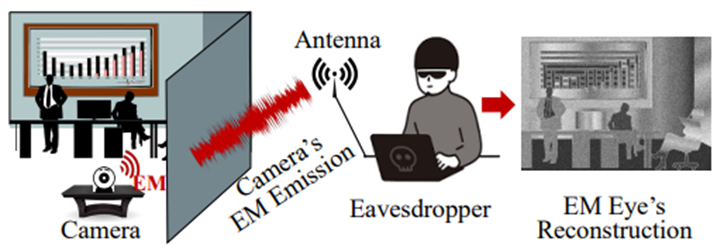Teacher
Professional
- Messages
- 2,670
- Reaction score
- 814
- Points
- 113
EM Eye allows you to capture images from cameras without hacking it.
Scientists from Northeastern University in the United States have developed a new technique that can intercept video signals from most modern cameras, even through walls. The method, dubbed EM Eye, uses a radio antenna to collect electromagnetic radiation emitted by wires inside cameras that act as radio transmitters.
The technique is effective against various types of cameras, from home security systems and DVRs to smartphone cameras. During tests on 12 different camera models, it was found that to intercept the signal, it is necessary to be at a distance of less than 30 cm to almost 5 meters, depending on the camera model. The captured video was initially distorted due to pixel loss during transmission, but the video quality was significantly improved using machine learning.

Example of EM Eye operation
The technique presented at the IEEE Symposium on Security and Privacy raises serious concerns about privacy and security. Anyone with engineering skills and equipment costing several hundred dollars can spy unnoticed through any camera nearby.
The researchers suggest that camera manufacturers should consider shielding the wires inside the devices or encrypting video data to prevent such attacks. Experts point to a problem in the design and production of cameras that protect only digital interfaces, ignoring possible data leakage through wires. Scientists also advise users to study the risks and avoid placing cameras in sensitive areas.
The technique is based on the principle of electromagnetic induction, according to which a changing magnetic field can induce an electric current in a conductor. This method differs from other methods of espionage, such as hacking a wireless network or intercepting data from cloud storage, without requiring access to the network or storage of the camera and without leaving traces of interference.
The researchers note that the new method can be applied not only to cameras, but also to other devices that transmit video data via wires, such as monitors, laptops or tablets. Despite potentially legitimate applications, such as forensic testing, there is a threat to personal and national security. The developers hope that their work will raise awareness of the problem and encourage the development of countermeasures to protect the privacy and security of camera users.
Scientists from Northeastern University in the United States have developed a new technique that can intercept video signals from most modern cameras, even through walls. The method, dubbed EM Eye, uses a radio antenna to collect electromagnetic radiation emitted by wires inside cameras that act as radio transmitters.
The technique is effective against various types of cameras, from home security systems and DVRs to smartphone cameras. During tests on 12 different camera models, it was found that to intercept the signal, it is necessary to be at a distance of less than 30 cm to almost 5 meters, depending on the camera model. The captured video was initially distorted due to pixel loss during transmission, but the video quality was significantly improved using machine learning.

Example of EM Eye operation
The technique presented at the IEEE Symposium on Security and Privacy raises serious concerns about privacy and security. Anyone with engineering skills and equipment costing several hundred dollars can spy unnoticed through any camera nearby.
The researchers suggest that camera manufacturers should consider shielding the wires inside the devices or encrypting video data to prevent such attacks. Experts point to a problem in the design and production of cameras that protect only digital interfaces, ignoring possible data leakage through wires. Scientists also advise users to study the risks and avoid placing cameras in sensitive areas.
The technique is based on the principle of electromagnetic induction, according to which a changing magnetic field can induce an electric current in a conductor. This method differs from other methods of espionage, such as hacking a wireless network or intercepting data from cloud storage, without requiring access to the network or storage of the camera and without leaving traces of interference.
The researchers note that the new method can be applied not only to cameras, but also to other devices that transmit video data via wires, such as monitors, laptops or tablets. Despite potentially legitimate applications, such as forensic testing, there is a threat to personal and national security. The developers hope that their work will raise awareness of the problem and encourage the development of countermeasures to protect the privacy and security of camera users.
